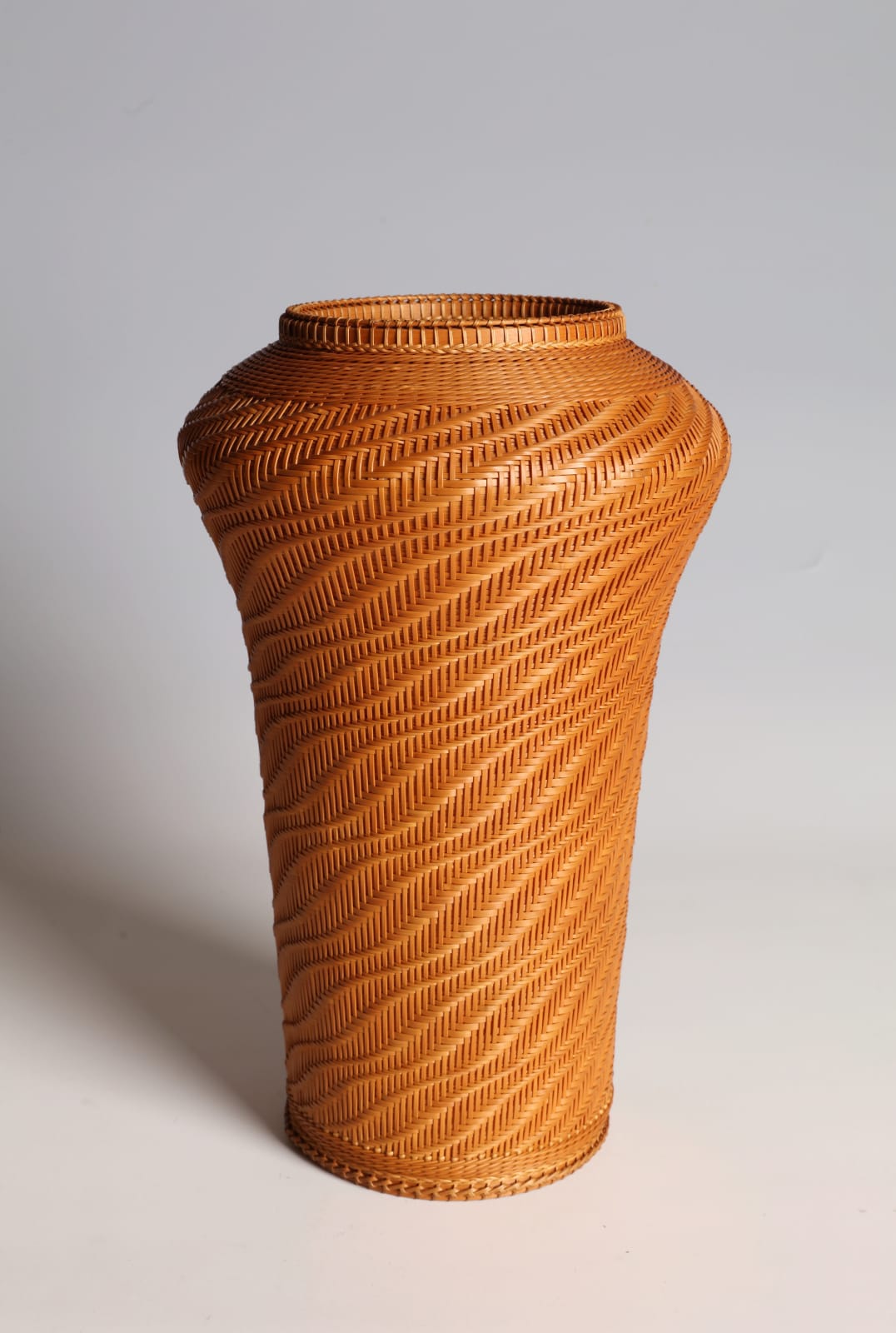Koide Fumio
“Ripples” Flower Basket, 1990s
Bamboo and rattan
Size 13¼ x 8¼ x 8¼ in. (33.7 x 21 x 21 cm)
T-5090
Leached madake (standard bamboo) and rattan; nihonyose ajiro-ami (double twill plaiting), tobi-gozame-ami (“skipping” mat plaiting), nawame (twining), knotting; with a black-lacquer otoshi (water holder) cut from a bamboo culm Signed...
Leached madake (standard bamboo) and rattan; nihonyose ajiro-ami (double twill plaiting), tobi-gozame-ami (“skipping” mat plaiting), nawame (twining), knotting; with a black-lacquer otoshi (water holder) cut from a bamboo culm
Signed underneath with a single character incised into a darker bamboo plaque Fumi
Cmoes with the original wood tomobako storage box inscribed and signed outside Hanakago Sazanami Fumio saku (Flower Basket Ripples, made by Fumio); seal: Fumio
Born in 1960 in Nagano City, Koide Fumio received his practical training in basketry in Oita Prefecture on the island of Kyushu, from the 1950s a major hub of government-sponsored bamboo education, studying under Iwai Shōtarō. He began exhibiting his widely varied works at the Japan Traditional Craft Exhibition in the early 1990s and is now recognized as a leading figure in the bamboo art world of mountainous Nagano Prefecture (northwest of Tokyo). Unlike other centers such as Oita, Tochigi Prefecture, Niigata Prefecture, or Sakai (part of Osaka), Nagano does not boast a long history of artistic basketry and Koide’s work is unusually free from traditional influences.
The shape of this basket, like many crafted in Japan since bamboo weaving rose to the level of fine art in the late Edo period (1615–1868), draws its inspiration from ceramics—specifically, wheel-thrown vessels. But rather than the more typical Chinese models, this piece seems to echo the elegant contours of Korean maebyeong vases from the late Goryeo Dynasty (918-1392)—tall, high-shouldered forms that have long been treasured in Japanese collections.
To capture the grace of a ceramic silhouette and reinterpret it in as a virtuoso bamboo basket, Koide began at the very center of the base. There, he used a small patch of double twill plaiting, a tightly woven technique, to serve as the foundation. From this point, he extended radiating strips outward, setting the stage for a striking version of gozame, traditional “mat” plaiting. He wove circumferential strands through the radial ones in a two-under, two-over rhythm, arranged to create a rising or “skipping” pattern that added movement and visual interest.
For the tall sides, Koide intensified the “skipping” effect by weaving the horizontal (formerly circumferential) strands five-under and two-over through the vertical (formerly radial) strands, a bold variation that amplified the rhythm and gave rise to the sazanami, or “ripple,” pattern—an undulating texture that lends the basket its name and character. As the form reached the shoulder, Koide abandoned mat-plaiting in favor of nawame (twining), layering about a dozen rows to transition smoothly into the rim. The basket was then finished with a bent bamboo mouth, elegantly secured by slender knotted strips, likely made of rattan, the tendrils of an imported trailing vine favored by bamboo artists for its flexibility and strength.
Signed underneath with a single character incised into a darker bamboo plaque Fumi
Cmoes with the original wood tomobako storage box inscribed and signed outside Hanakago Sazanami Fumio saku (Flower Basket Ripples, made by Fumio); seal: Fumio
Born in 1960 in Nagano City, Koide Fumio received his practical training in basketry in Oita Prefecture on the island of Kyushu, from the 1950s a major hub of government-sponsored bamboo education, studying under Iwai Shōtarō. He began exhibiting his widely varied works at the Japan Traditional Craft Exhibition in the early 1990s and is now recognized as a leading figure in the bamboo art world of mountainous Nagano Prefecture (northwest of Tokyo). Unlike other centers such as Oita, Tochigi Prefecture, Niigata Prefecture, or Sakai (part of Osaka), Nagano does not boast a long history of artistic basketry and Koide’s work is unusually free from traditional influences.
The shape of this basket, like many crafted in Japan since bamboo weaving rose to the level of fine art in the late Edo period (1615–1868), draws its inspiration from ceramics—specifically, wheel-thrown vessels. But rather than the more typical Chinese models, this piece seems to echo the elegant contours of Korean maebyeong vases from the late Goryeo Dynasty (918-1392)—tall, high-shouldered forms that have long been treasured in Japanese collections.
To capture the grace of a ceramic silhouette and reinterpret it in as a virtuoso bamboo basket, Koide began at the very center of the base. There, he used a small patch of double twill plaiting, a tightly woven technique, to serve as the foundation. From this point, he extended radiating strips outward, setting the stage for a striking version of gozame, traditional “mat” plaiting. He wove circumferential strands through the radial ones in a two-under, two-over rhythm, arranged to create a rising or “skipping” pattern that added movement and visual interest.
For the tall sides, Koide intensified the “skipping” effect by weaving the horizontal (formerly circumferential) strands five-under and two-over through the vertical (formerly radial) strands, a bold variation that amplified the rhythm and gave rise to the sazanami, or “ripple,” pattern—an undulating texture that lends the basket its name and character. As the form reached the shoulder, Koide abandoned mat-plaiting in favor of nawame (twining), layering about a dozen rows to transition smoothly into the rim. The basket was then finished with a bent bamboo mouth, elegantly secured by slender knotted strips, likely made of rattan, the tendrils of an imported trailing vine favored by bamboo artists for its flexibility and strength.
